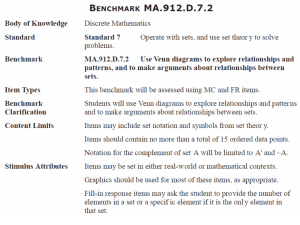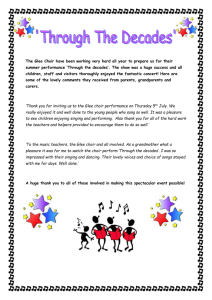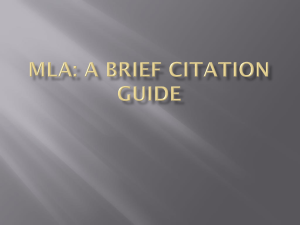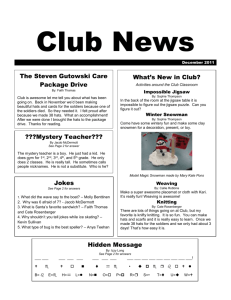Teaching GLEE-dership - Journal of Leadership Education
advertisement
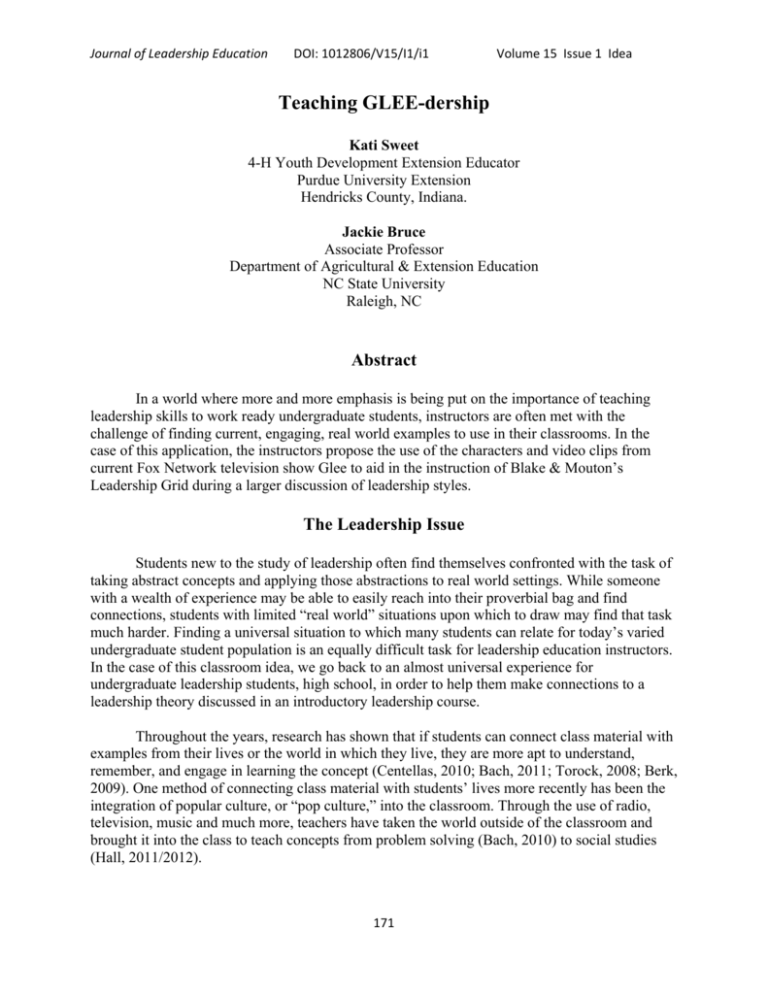
Journal of Leadership Education DOI: 1012806/V15/I1/i1 Volume 15 Issue 1 Idea Teaching GLEE-dership Kati Sweet 4-H Youth Development Extension Educator Purdue University Extension Hendricks County, Indiana. Jackie Bruce Associate Professor Department of Agricultural & Extension Education NC State University Raleigh, NC Abstract In a world where more and more emphasis is being put on the importance of teaching leadership skills to work ready undergraduate students, instructors are often met with the challenge of finding current, engaging, real world examples to use in their classrooms. In the case of this application, the instructors propose the use of the characters and video clips from current Fox Network television show Glee to aid in the instruction of Blake & Mouton’s Leadership Grid during a larger discussion of leadership styles. The Leadership Issue Students new to the study of leadership often find themselves confronted with the task of taking abstract concepts and applying those abstractions to real world settings. While someone with a wealth of experience may be able to easily reach into their proverbial bag and find connections, students with limited “real world” situations upon which to draw may find that task much harder. Finding a universal situation to which many students can relate for today’s varied undergraduate student population is an equally difficult task for leadership education instructors. In the case of this classroom idea, we go back to an almost universal experience for undergraduate leadership students, high school, in order to help them make connections to a leadership theory discussed in an introductory leadership course. Throughout the years, research has shown that if students can connect class material with examples from their lives or the world in which they live, they are more apt to understand, remember, and engage in learning the concept (Centellas, 2010; Bach, 2011; Torock, 2008; Berk, 2009). One method of connecting class material with students’ lives more recently has been the integration of popular culture, or “pop culture,” into the classroom. Through the use of radio, television, music and much more, teachers have taken the world outside of the classroom and brought it into the class to teach concepts from problem solving (Bach, 2010) to social studies (Hall, 2011/2012). 171 Journal of Leadership Education DOI: 1012806/V15/I1/i1 Volume 15 Issue 1 Idea Using various pop culture mediums, such as television, in the classroom “can create authentic, meaningful and transformative teaching encounters with students of all levels” (Bach, 2011, p. 144). Berk (2009) claims another benefit to using these pop culture catalysts, such as video clips, in the classroom is that they may have both a cognitive and emotional effects on students because it engages both hemispheres of the brain. Students are able to connect with the content being discussed through video clips because “auditory/verbal and visual/pictorial stimuli increase memory, comprehension, understanding, and deeper learning” (p. 5). Theoretical Frame and Review of Related Scholarship Why pop culture in the classroom? To better understand the background of those decisions, three areas must be reviewed: popular culture as pedagogy, TV shows in the classrooms, and TV shows utilized in leadership education class settings. Popular Culture as Pedagogy. Guy (2007) describes popular culture as “knowledge and values embedded in the lived experiences of people in their strivings for individual and collective fulfillment and meaning” (p. 16). Popular culture, or “pop culture,” takes on many forms including TV shows, radio, movies, newspapers, art, and even the internet. These outlets “develop and disseminate messages about what the society sees as important, valuable, ideal or desirable” (p. 16). Guy (2007) utilized pop culture while teaching a multicultural-issues class to discuss race, class and gender issues. One assignment was to select a TV series to watch and students would then report on the ways race, class and gender were represented. Another assignment was to review clips from the movie Crash. Afterward students discussed the scene and its portrayal of race, gender, and class. During these assignments, Guy expressed the importance of not imposing their analysis of the excerpts on the students. “Students have different interpretations of the pop-culture examples that I use,” stated Guy (p. 21). The researcher found that students were able to analyze and critique pop culture in order to gain a better understanding of race, gender, and class issues. They also found that “educators of adults can develop powerful educational strategies by employing a critical stance toward popular culture in the activities they design and deliver” (p. 15). TV Shows in the Classroom. With instant access to movie and television show clips through websites like YouTube, movieclips.com, and network websites available at professors’ fingertips, the idea of incorporating videos into a classroom is not new. The key, however, is to find the types of clips that resonate with students in the here and now. According to Berk (2009), there are twelve ways educators could incorporate video usage into their teachings: 1. Provide content and information 2. Illustrate a concept or principle 3. Present alternative viewpoints 4. Apply content to real-world applications 5. Serve as a stimulus for learning activities 6. Provide a good or bad application to critique 7. Exaggerate a particular point 8. Snap students to attention 9. Insert into collaborative learning exercises 10. Motivate and inspire 172 Journal of Leadership Education DOI: 1012806/V15/I1/i1 Volume 15 Issue 1 Idea 11. Provide a commercial break 12. Signal a return from a class break Beavers (2002) utilized the West Wing to illustrate governmental issues. Bach (2008) discussed using the TV show Amazing Race to relate students to the concept of problem-based learning. Another researcher, Miguel Centellas (2010) used the TV show American Idol in his class to discuss Karl Marx and Alexis de Tocqueville with students. Centellas went on to say that using TV shows in the classroom “not only help make otherwise dry material more fun for undergraduates, but they also help students hone critical thinking skills, integrate classroom lessons into the real world…and build holistic understandings of learning and exploration” (p. 562). He also discussed some disadvantages by stating that some pop culture references may not be understood by international students, or a professor may have a hard time finding a relevant scene that relates to the class content. By utilizing American Idol, Centellas (2010) gave students the assignment of writing a paper using passages from Marx and Tocqueville to apply to the show. TV Shows in Leadership Education. Not only have TV shows been used in various college classes, they have also been used in leadership education classes. Torock (2008) developed a method of using the TV show Grey’s Anatomy to discuss situational leadership. The researcher found that the show was a perfect fit for the subject because “throughout the series different characters illustrate the directing, coaching, supporting, and delegating styles of leadership in casual, work, life-threatening, and high intensity situations” (p. 73). Torock (2008) used discussion after the viewing of the TV clips to stimulate additional learning. She found that video clips help students relate the leadership lesson to real life, especially if they are unsure of how to connect the concept to their personal lives. Exposition of the Idea “The best teachers don’t give you the answers. They just point the way and let you make your own choices – your own mistakes. That way, you get all the glory, and you deserve it” (“Will Schuester”, Glee, ep. 1.12). Will Schuester is just one of the many characters on the TV show Glee. According to FOX (2014), Glee is a musical comedy based on a high school Glee Club in small town Lima, Ohio at William McKinley High School. The show follows students who are seen as outcasts by many, but find a place within the glee club that becomes like family. The students within the show deal with many real-life situations that typical high school students could face (crushes, school problems, sports drama, graduation, etc.). The Glee high school setting, while certainly not the “norm”, still has threads that would be familiar to most of our undergraduate students. Throughout the seasons and the situations they face, Glee characters develop and provide examples of both good and poor leadership qualities. From that base, we build our lessons for Blake and Mouton’s Leadership Grid. Blake and Mouton (1964) created a Managerial Grid that displayed five types of leadership: Impoverished, Country Club, Produce or Perish (Dictatorial), Team, and Middle-ofthe-road. The grid is based on two axes: “human interaction” and “the job itself” (Gregoire, 173 Journal of Leadership Education DOI: 1012806/V15/I1/i1 Volume 15 Issue 1 Idea Fada, and Arendt, 2004, p. 395). The dimensions proposed by Blake and Mouton (1964) represent the struggle leaders face in deciding the appropriate amount of time necessary to designate to people and production in an organization. According to Pheng and Lee (1997), the concern for the job, or production, “would include results, bottom line or profits,” while the concern for people may include “getting results based on trust, respect, obedience, understanding, or support” (p. 395). The goal of this classroom innovation is to use video clips from the TV show Glee to demonstrate leadership styles from Blake & Mouton’s Managerial Grid (1964). Students would be shown clips of Glee characters in various situations, sometimes taking on formal leadership roles, other times not, and then asked to assign each character to a quadrant of the Grid and think about why they chose those assignations. This will be done individually first, and then each student will be asked to “pair share” by turning to a student close to them and comparing answers and justifications. Full class discussion would include reasoning for placement of characters, situational influence of leadership style, and whether or not a character switches styles. Using Glee in the classroom would also promote the fourth concept Berk (2009) discussed: “Applying content to real-world applications” (p. 10) because in each situation, students would also be asked to reflect on the illustration and relate it to their own lives. Preliminary character identification includes: Produce or Perish Leader- Coach Sue Sylvester. Coach Sue Sylvester is the Cheerleading Coach and later Principal of McKinley High. Zeidan (2009) said that Produce or Perish leaders find “employees needs unimportant and simply a means to an end” (p. 84). Sue can often be found tormenting students, especially the Glee Club, and makes it a point to constantly remind everyone that she is an award winning coach. When in a leadership role, Sue tends to be bossy and only cares about winning. An example clip would show Sue, sitting on the bleachers in the gymnasium yelling at her cheerleaders while extolling the virtues of winning “her” next national cheerleading championship. Team Leader- Mr. Will Schuster. Will Schuester is the one time Spanish teacher and Glee Club Director at WMHS. Will actually brought the Glee club back to McKinley High. A Team Leader is one who has high concern for both production and people. Northouse (2013) describes team leaders as people who “stimulate participation, acts determined, gets issues into the open, makes priorities clear, follows through, behaves open mindedly, and enjoys working” (p. 81). Will acts almost like a father figure to many of the youth involved in the Glee Club. He takes their feelings and thoughts into consideration when making choices. In each episode the Glee Club has a different topic/theme that Will chooses on which he wants the students to work. Most of the time, these topics reflect what is happening in the lives of the Glee Club members. Because the topics relate to the members, they buy into the lesson and (usually) end up learning something about themselves and others by the end of an episode. An example clip that might be shown to demonstrate Will’s team leadership style might be clips showing Will discussing how the girls in the Glee Club feel less important while teaching a lesson on singing songs by artists of the opposite gender to understand how other’s think and feel. Impoverished Leader- Rachel Berry. Rachel Berry is a past Glee Club star, and a former Glee Club member as she has gone off to college in recent seasons. In many cases, Glee 174 Journal of Leadership Education DOI: 1012806/V15/I1/i1 Volume 15 Issue 1 Idea Diva Rachel cares neither for people, nor the task at hand, and thinks only of herself, and her future stardom. Northouse (2013) would also describe Rachel as opportunistic, because she uses her leadership for the “purpose of self-advancement” (p.82). An example clip to show Rachel’s impoverished style might be to show Rachel sabotaging a potential Glee club rival by putting her in physical danger to thwart the newbie’s efforts to try out for the club and potentially dethrone Rachel, thus maintaining and securing Rachel’s place as the star of the club. Country Club Leader- Finn Hudson. Finn Hudson is another former Glee Club Member. Finn is often recognized as the moral center of the Glee Club and its members past and current. Northouse (2013) describes Country Club leaders as individuals who create positive climates by being “agreeable, eager to help, comforting and uncontroversial” (p.79) Though Finn wants to see the Glee Club succeed, his first concern is always the well-being of the students in the club. Whether serving as co-leader while a student, or stand in Director after graduation, Finn wore his heart and his concern for others on his sleeve. An example clip that might be shown of Finn acting in the country club style might be when he set aside his own feelings, football practice and glee rehearsal to dress up in like Lady Gaga to prove to his Step Brother Kurt that he did care about him and wanted to understand what he was going through as an “out” high school student being picked on by members of the “jocks”. Middle of the Road Leader- Sam Evans. Sam Evans is another former Glee Club Member. Sam joined the Glee Club as a new student and was quickly taken under Finn’s wing, helping to define Sam’s character. Described by Northouse (2013) as someone who balances concerns for tasks to be completed and the team completing them, Sam can usually be found sitting back, relaxing, taking everything in. You won’t see Sam participating in some of the heated Choir Room arguments, instead, he is often the peace maker, jumping in and encouraging people to find a compromise. One clip that can be used in class to show Sam’s Middle of the Road Leadership is when he and Blaine run a Glee Club practice. While their director is out with the flu, Blaine and Sam realize their club cannot give up a practice so close to the regional competition. They gather the group together and explain that the assignment for the week is “guilty pleasure” songs; the songs that get stuck in your head while driving when you hear it on the radio. Sam explains that by singing about their “guilty pleasures,” the group will not only have more practice for regionals, but will be able to grow as a team by sharing these songs because they are a little more personal than the songs they normally sing in class. Sam and Blaine then go on to sing “Wake Me Up Before You Go-Go” to the class to get them to loosen up and excited about working together while also getting in valuable practice time. Anticipated Outcomes, Reflections and Recommendations As with any pop culture example, we acknowledge that students will view these examples through their own lens, thusly making these examples more effective for some than others. The hope, however, is that these examples, like Torock (2008) or Centellas (2010), will help students make “real life” connections to the content. We also realize that we may face certain limitations including cultural and language barriers with international students (Centellas, 2010), but are prepared to give some history or background when needed to help students understand the clips shown. 175 Journal of Leadership Education DOI: 1012806/V15/I1/i1 Volume 15 Issue 1 Idea A secondary outcome of the infusion of pop culture items in the classroom, will be to have students provide their own relevant pop culture examples to this and other course content. Use of pop culture is tricky, in that examples can become dated fairly quickly. By allowing students to suggest pieces that they believe are culturally relevant and timely, we build our own pop culture toolkit, so as more opportunities arise for these types of inclusions, more can be provided. If the use of this pop culture lesson is well received, others may be included for different parts of other units. We have entertained the notion of using one television show throughout an introductory course, which would provide consistency in seeking examples. We have also entertained the idea of using a variety of television shows, attaching a show to each unit of study, to help engage the learners in making connections. References Bach, J. (2011). How teachers negotiate the use of reality television in their pedagogy. Pedagogies: An International Journal, 6(2), 144-153. Bach, J. (2008). A problem-based learning approach based on reality TV? Academic Exchange Quarterly, 12(1), 153-157. Beavers, S.L. (2002). The West Wing as a pedagogical tool. PS: Political Science and Politics, 35, 213-216. Blake, R.R., & Mouton, J.S. (1964). The managerial grid. Houston: Gulf. Berk, R.A. (2009). Multimedia teaching with video clips: TV, movies, YouTube, and mtvU in the college classroom. International Journal of Technology in Teaching and Learning, 5(1), 1- 21. Centellas, M. (2010). Pop culture in the classroom: American Idol, Karl Marx, and Alexis de Tocqueville. The Teacher, July, 561-565. Fox. (2014). Glee. Retrieved from http://www.fox.com/glee. Gregoire, M.B., Fada, R.D., & Arendt, S.W. (2004). Leadership: Reflections over the past 100 years. Journal of American Dietetic Association, 104, 395-403. Guy, T.C. (2007). Learning who we (and they) are: Popular culture as pedagogy. New Directions for Adult and Continuing Education, 115, 15-23. Doi: 10.1002/ace.263 Hall, L.A. (2011/2012). How popular culture texts inform and shape students’ discussions of social studies text. Journal of Adolescent & Adult Literacy, 55(4), 296-305. Doi: 10.1002/JAAL.00036. 176 Journal of Leadership Education DOI: 1012806/V15/I1/i1 Volume 15 Issue 1 Idea Northouse, P. (2013). Leadership Theory and Practice. Los Angeles: Sage. Pheng, L.S. & Lee, B.S.K. (1997). “Managerial grid” and Zhuge Liang’s “Art of management”: Integration for effective project management. Management Decision, 35(5), 382-391. Torock, J.L. (2008). Bringing the emergency room to the classroom: Using Grey’s Anatomy to simplify situational leadership. Journal of Leadership Education, 7(2), 69-77. Zeidan, H. (2009). The Blake Mouton Managerial Grid: Identifying five different leadership styles. The Certified Accountant, 39(3r Quarter), 82-85. Author Biographies Kati Sweet, nèe Ingerson received her M.S. in Extension Education from NC State and now works as a 4-H Youth Development Extension Educator with Purdue Extension in Hendricks County, Indiana. Jacklyn Bruce is an Associate Professor in the Department of Agricultural and Extension Education at North Carolina State University. 177

